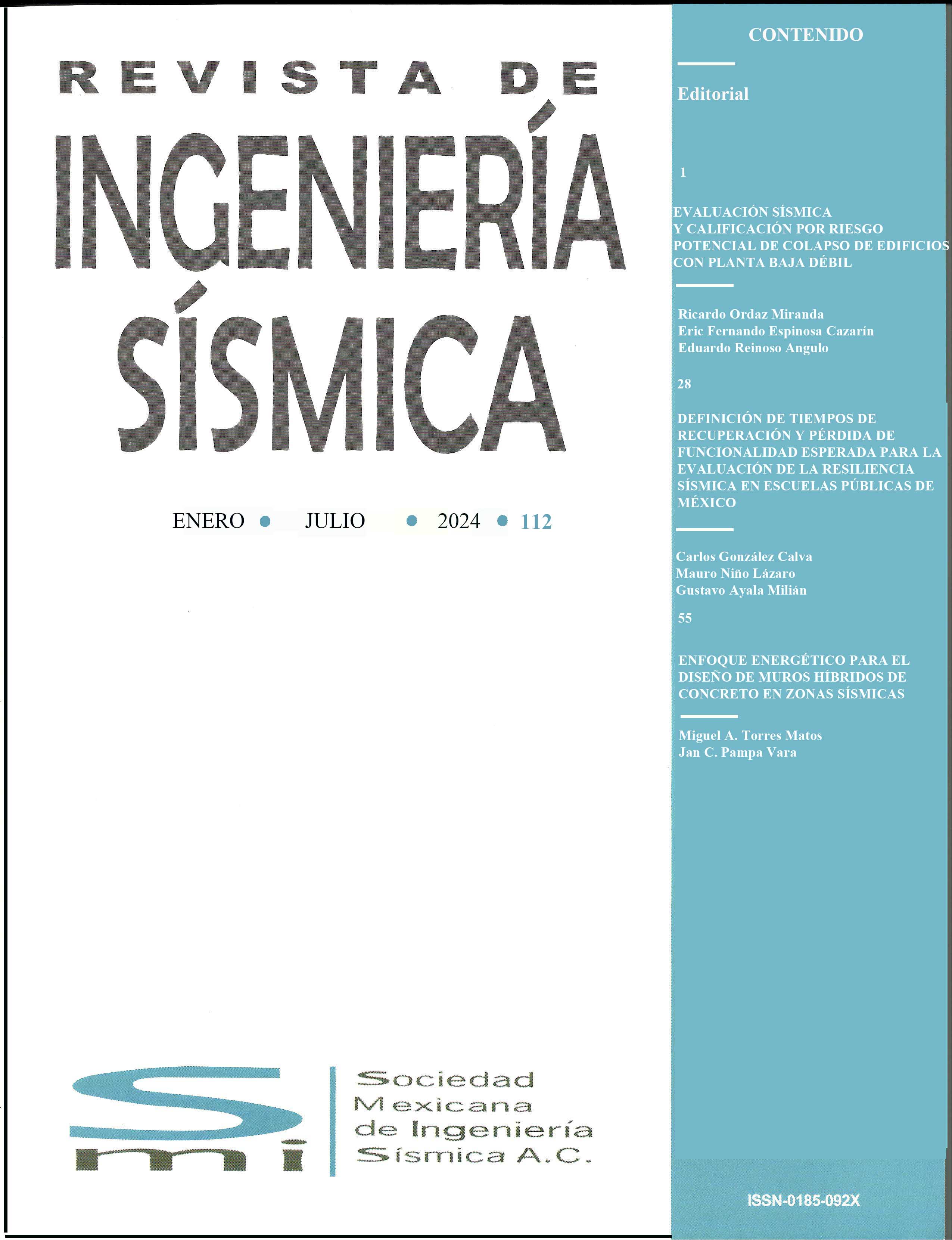DIMENSIONADO PRELIMINAR BASADO EN RIGIDEZ DE EDIFICIOS ALTOS CON ESTRUCTURA DE ACERO RIGIDIZADOS CON DIAGONALES CONCÉNTRICAS
DOI:
https://doi.org/10.18867/ris.90.13Resumen
Se presenta una metodología para el dimensionado preliminar de un sistema resistente a sismos estructurado con base en marcos de acero rigidizados con diagonales concéntricas. La metodología aplica para el caso de edificios altos, cuya respuesta queda influida por componentes de deformación global en flexión y por el efecto de modos superiores de vibrar. Se presenta el dimensionado preliminar de los elementos estructurales de diferentes versiones de un sistema de contraventeo para un edificio de 24 pisos. A partir de la evaluación de las características dinámicas de las diferentes versiones del sistema de contraventeo, se concluye que la metodología propuesta conduce a un dimensionado adecuado durante el diseño preliminar basado en desempeño de edificios altos de acero contraventeados.
Descargas
Citas
Baker, W (1990), “Sizing technique for lateral systems in multi-story steel building,” 4th World Congress on Tall Buildings, pp. 868-875, Hong Kong, China.
Baldock, R y K Shea (2006), “Structural topology optimization of braced steel frameworks using genetic programming,” Intelligent Computing in Engineering and Architecture, Lecture Notes in Computer Science, vol. 4200/2006, pp. 54-61.
Bertero, R y V V Bertero (1992), “Tall reinforced concrete buildings: conceptual earthquake-resistant design methodology,” Reporte UCB/EERC-92/16, Universidad de California en Berkeley.
Chan, C M y D E Grierson (1993), “An efficient resizing technique for the design of tall buildings subject to multiple drift constraints,” The Structural Design of Tall and Special Buildings, vol. 2 (1), pp. 17-32.
Federal Emergency Management Agency (2000), “FEMA 356, Prestandard and commentary for the seismic rehabilitation of buildings.”
Kameshki, E S y M P Saka (2001), “Genetic algorithm based optimum bracing design of non-swaying tall plane frames,” Journal of Constructional Steel Research, vol. 57, pp. 1081-1097.
Kim, C K, H S Kim, J S Hwang y S M Hong (1998), “Stiffness-based optimal design of tall steel frameworks subject to lateral loading,” Structural Optimization, vol. 15, pp. 180-186.
Liang, Q Q, Y M Xie y G P Steven (2000), “Optimal topology design of bracing systems for multi-story steel frames,” ASCE Journal of Structural Engineering, vol. 126 (7), pp. 823-829.
Moehle, J P (2008), “Performance-based seismic design of tall buildings in the U.S.,” 14th World Conference on Earthquake Engineering (CD), Beijing, China.
Montiel-Ortega, M A y A Terán-Gilmore (2013), “Comparative reliability of two twenty-four story braced buildings: traditional versus innovative,” The Structural Design of Tall and Special Buildings, vol. 22 (8), pp. 635-654.
Moon, K-S, J J Connor y J E Fernandez (2007), “Diagrid structural systems for tall buildings: characteristics and methodology for preliminary design,” The Structural Design of Tall and Special Buildings, vol. 16, pp. 205-230.
Moon, K-S (2008), “Sustainable structural engineering strategies for tall buildings,” The Structural Design of Tall and Special Buildings, vol. 17, pp. 895-914.
Park, H S, K Hong y J H Seo (2002), “Drift design of steel-frame shear-wall systems for tall buildings,” The Structural Design of Tall Buildings, vol. 11, pp. 35-49.
Park, H S y J H Kwon (2003), “Optimal drift design model for multi-story buildings subjected to dynamic lateral forces,” The Structural Design of Tall and Special Buildings, vol. 12, pp. 317-333.
Priestley, M J N (2000), “Performance based seismic design,” 12th World Conference on Earthquake Engineering (CD), Auckland, Nueva Zelanda.
Soong, T T y B F Spencer (2002), “Supplemental energy dissipation: state-of-the-art and state-of-the practice,” Engineering Structures, vol. 24, pp. 243-259.
Terán-Gilmore, A y J Ruiz-Garcia (2010), “Comparative Seismic Performance of Steel Frames Retrofitted with Buckling-Restrained Braces through the Application of Force-Based and Displacement-based Approaches,” Soil Dynamics and Earthquake Engineering, vol. 31, pp. 478-490.
Terán-Gilmore, A y G Coeto (2011), “Displacement-Based Preliminary Design of Tall Buildings Stiffened with a System of Buckling-Restrained Braces,” Earthquake Spectra, vol. 27 (1), pp. 153-182.
Tremblay, R, P Bolduc, R Neville y R DeVall (2006), “Seismic testing and performance of buckling-restrained bracing systems,” Canadian Journal of Civil Engineering, vol. 33, pp. 183-198.
Uang, C M y M Nakashima (2003), “Steel buckling-restrained braced frames,” Earthquake Engineering: Recent Advances and Applications, Capítulo 16, CRC Press.
Wada, A, Y Huang y V V Bertero (2003), “Innovative strategies in earthquake engineering,” Earthquake Engineering: Recent Advances and Applications, Capítulo 10, CRC Press.
Zou, X-K y C-M Chan (2005), “An optimal resizing technique for seismic drift design of concrete buildings subjected to response spectrum and time history loadings,” Computers and Structures, vol. 83, pp. 1689-1704.







